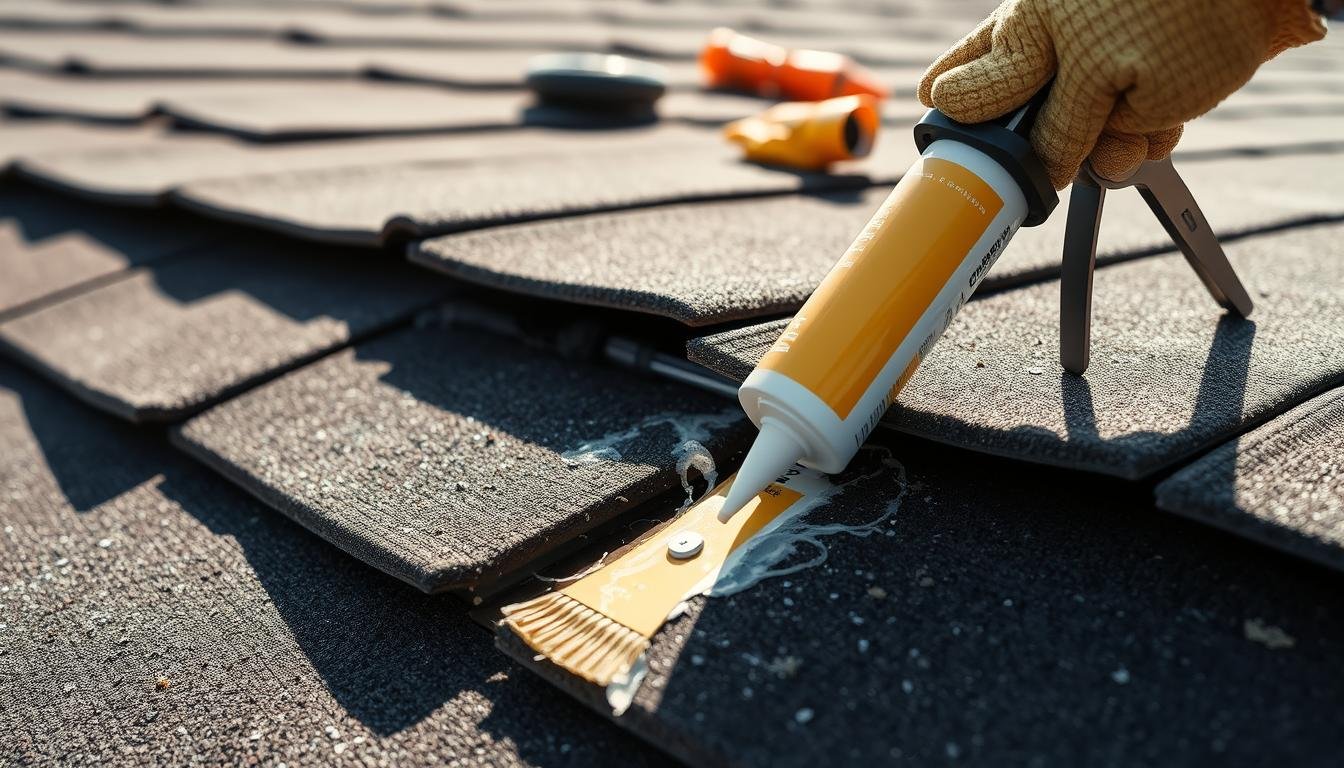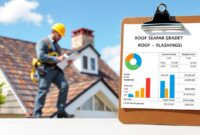Ever wondered how to stop roof leaks quickly? This guide shows you the best leak repair sealants. They can make your leaky roof dry and secure fast.
But first, let’s ask a question: Are you tired of mopping up water damage and wondering when the next storm will expose a new leak? Roof leaks are common and can be costly. Finding the right sealant is key.
Read also: Signs of Roof Leak in Attic
Next, I’ll explain why roof leaks need fixing. Then, I’ll cover what makes a good sealant and how to use it. I’ll also recommend my top products to help you fix your roof.
Introduction: The Importance of Addressing Roof Leaks
As a homeowner, fixing roof leaks is very important. Leaks can harm your home’s structure and cause water damage, mold, and safety issues. I’ll show you why you need to act fast and how to find a lasting fix.

Protecting Your Home’s Integrity
A leaky roof can start many problems. Water can weaken the roof and cause it to sag or even collapse. It can also rot the wooden beams and trusses, making your home unstable.
Avoiding Costly Water Damage
Ignoring roof leaks can lead to water damage inside your home. This can damage walls, ceilings, and floors, costing a lot to fix. It can also cause mold, which is bad for your health. Quick roof leak prevention and roof waterproofing can save you from these problems.
Fixing roof leaks is key to keeping your home safe and healthy. By acting quickly, you can avoid bigger and more expensive issues. It’s a crucial part of home care.
“A stitch in time saves nine – the same applies to roof leak repair. Addressing the issue promptly can prevent much larger and more expensive problems down the line.”
Understanding Sealant For Roof Leak Repair
Fixing roof leaks is crucial for homeowners. This is essential for a fast and effective fix. They seal and waterproof damaged roof areas, stopping further damage.
There are many types of it, each has its own strengths and how you apply them. Knowing about silicone, liquid rubber, and other sealants helps you pick the right one for your roof.
Silicone-Based Roof Sealants
Silicone-based sealants are known for their durability and flexibility. They can handle extreme weather, like UV rays and temperature changes. This makes them a great choice for lasting roof repairs.
Liquid Rubber Roof Sealants
Liquid rubber sealants are versatile for sealing leaks. They create a strong, waterproof layer. Their flexibility also means they can move with your roof.
Acrylic Roof Sealants
Acrylic sealants are affordable and reliable. They’re easy to use and resist UV rays well. This makes them good for many roofing types.
Choosing the right sealant is key. Always follow the manufacturer’s application guide. Make sure the surface is ready for the best results.
Knowing about roof sealant, through the roof sealant, and liquid rubber sealant helps you make a smart choice. This way, you can fix your roof leak issues well.
Identifying the Source of Your Roof Leak
Fixing a roof leak can seem tough, but finding the source is the first step. A detailed roof inspection helps you locate the leak. Then, you can use the correct roof leak solution to fix it.
Read also: How Much Is a Roof Inspection?
Roof Inspection Techniques
Start by looking at your roof for damage like cracked shingles or missing flashing. If you can’t find the leak, try water testing. Spray water on the area and see where it leaks in.
Thermal imaging cameras are also helpful. They show temperature differences that might mean a leak is there.
Common Leak Locations
- Around vents, chimneys, or other roof penetrations
- Along the roof’s edges, where the shingles meet the gutters or fascia
- In valleys, where two roof planes intersect
- Near skylights or other roof-mounted accessories
- In areas with previous repairs or sealant failures
By carefully checking your roof and finding the leak, you’re on the right path. You’ll be able to fix your roof and keep your home safe.
Identifying the source of a roof leak is the key to finding the right solution and preventing further damage to your home.
Preparing the Surface for Roof Leak Repair Sealant Application
Getting your roof ready for sealant is crucial. Before you start, clean and prepare the area well. This ensures the sealant sticks and lasts, keeping your home dry.
Here’s how to get your roof ready:
- Inspect the area: Look closely at the leak spot for cracks or damage. This tells you how much work you need to do.
- Clean the surface: Use a brush or pressure washer to remove dirt and debris. This makes the surface smooth for the sealant.
- Dry the surface: Make sure it’s dry before applying the sealant. Use a cloth or drying tool to remove any moisture.
- Apply a primer (if necessary): Depending on your roof and sealant, you might need a primer. It helps the sealant stick better.
By following these steps, you’ll create a strong, watertight roof coating or roof waterproofing solution. This will protect your home from future leaks.
Proper surface preparation is the foundation for a successful roof leak repair. Take the time to do it right, and you’ll be rewarded with a long-lasting, reliable solution.
Roof Leak Repair Sealant: The Key to a Quick Fix
Choosing the right sealant is crucial for fixing roof leaks. Different sealants have unique properties for various needs. Let’s look at the types of sealants and how they can solve your roofing problems.
The most common types of repair sealants include:
- Silicone-based sealants – Flexible and durable, silicone sealants are a top pick for fixing roof leaks. They create a lasting, waterproof seal and can handle harsh weather.
- Acrylic-based sealants – These sealants offer a strong, flexible seal and are simple to apply. They’re ideal for small roof leaks and minor cracks.
- Liquid rubber sealants – Liquid rubber sealants form a seamless, watertight membrane. They’re great for fixing larger or more complex roof leaks.
- Polyurethane sealants – Polyurethane sealants have excellent adhesion and flexibility. They’re suitable for various roofing materials and roof leaks.
When picking, think about your roof’s needs, the leak’s size and location, and how easy it is to apply. Talking to a roofing expert can help you choose the best roof sealant for leaks for your roof.
“The right roof leak repair sealant can be a game-changer, transforming a troublesome leak into a quick, long-lasting fix.”
Step-by-Step Guide: Applying Roof Sealant
Applying sealant right is key for a lasting fix. I’ll show you how to do it step by step. We’ll cover everything from getting ready to applying the sealant, so you get the best results.
Start by checking the area and finding where the leak is. After you find it, clean the surface well. Remove any dirt, debris, or old sealant. This makes the new sealant stick better.
Then, pick a top-notch sealant that fits your roof. Roof repair sealant application is important, so read the instructions well. Spread the sealant evenly over the leaky area.
- Clean the surface well to get rid of dirt and old sealant.
- Choose a good roof leak fix sealant that matches your roof.
- Put the sealant on in a smooth layer, covering the whole leaky area.
- Let the sealant dry as the maker says, then check it.
- Make sure the seal is tight and watertight.
After that, let the sealant dry fully, as the maker suggests. Once it’s dry, check to see if the seal is tight. With these easy steps, you’ll fix that roof leak for good.

Proper sealant application is the key to a long-lasting, watertight fix.
Best Roof Sealant for Leaks: Top Product Recommendations
Not all roof sealants are the same. I’ve tested many to find the best for fixing leaks. These top choices include silicone and acrylic formulas that last long and work well.
- Flex Seal Liquid Rubber Sealant – This liquid rubber works on many surfaces, including roofs. It’s waterproof, easy to use, and sticks well for lasting results.
- SIKAFLEX-1A Pro Polyurethane Sealant – Known for its flexibility and weather resistance, this sealant is a premium choice. It creates a strong, flexible seal that lasts through weather changes.
- GE Silicone Roof and Flashing Sealant – This silicone sealant lasts a long time. It’s flexible and doesn’t crack, even in harsh weather.
| Product | Key Features | Where to Buy |
|---|---|---|
| Flex Seal Liquid Rubber Sealant | Versatile, durable, easy to apply | Home Depot, Amazon, Lowe’s |
| SIKAFLEX-1A Pro Polyurethane Sealant | Excellent flexibility, superior weatherproofing | Amazon, Contractor supply stores |
| GE Silicone Roof and Flashing Sealant | Long-lasting, flexible, crack-resistant | Lowes, Home Depot, online retailers |
These roof sealant options are reliable and long-lasting. They fix leaks and protect your home. They work for small cracks or big damage, ensuring a job well done the first time.
“These sealants have been a game-changer for me. I’ve tried a lot of products, and these are by far the best at sealing my roof leaks and preventing further damage.”
Don’t let a leaky roof damage your home. With the right roof leak repair sealants, you can fix leaks fast and effectively. Try one of these top products today and end roof leaks for good.
Maintenance and Prevention: Keeping Your Roof Leak-Free
To keep your roof leak-free, you need to stay vigilant and take action early. Regular roof checks and quick fixes can save your home from costly leaks. This keeps your roof strong for a long time.
Regular Roof Inspections
Checking your roof often is crucial to catch problems early. I suggest doing roof checks yearly, in spring or fall when it’s not too hot or cold. Look for damaged shingles, loose flashing, and water signs.
Roof Repair and Replacement Considerations
If your roof needs fixing, do it fast. Leaks can cause water damage, mold, and harm your home’s structure. You might need to restore or replace your roof, depending on the damage.
Choosing a good roofing contractor is key for repairs or replacements. They can tell you what’s wrong and fix it right. This ensures your roof stays waterproof and in good shape.
| Roof Inspection Checklist | Roof Repair Considerations |
|---|---|
| Check for cracked, curled, or missing shingles | Extent of damage (minor repairs vs. full replacement) |
| Inspect flashing around chimneys, vents, and skylights | Age and condition of the existing roof |
| Look for signs of water damage or mold | Examine the condition of gutters and downspouts |
| Examine the condition of gutters and downspouts | Estimated cost and timeline for the project |
By keeping up with roof checks and fixing problems quickly, you can keep your roof in great shape. This protects your home from the weather for many years.
DIY vs. Professional Roof Leak Repair: When to Call in the Experts
Using roof repair sealants can save you money, but sometimes you need a pro. Knowing when to call a roofing contractor is key. It’s important to recognize when a roof leak is too big for DIY fixes.
If it doesn’t work, or if the leak is hard to get to, get a pro. Roofing experts can find and fix the real problem. They also check for any structural damage that might be causing the leak.
Older roofs or those with big damage, like missing shingles, need a pro too. They can give you the best advice on repairs or a new roof. This saves you time, money, and stress from dealing with leaks.



